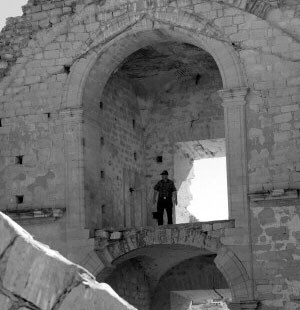
By Ginny Sphar
Father Bernardo was one of five missionaries who arrived from Germany in 1756 to begin their missionary careers in New Spain.[1] He did not set foot in the San Xavier-Santa Catalina-Tucson area until after the attack on Father Alonso Espinosa at San Xavier, by Jabanimó, the Gileño chief, in early 1756.[2] Colonel Juan Mendoza, Governor of Sonora, organized a punitive expedition of soldiers from various presidios and natives. Captain Francisco Elías from Terrenate was second in command. As they rode through San Ignacio they acquired the services of a chaplain, Father Middendorf, the Westphalian cartographer.[3] On January 5, 1757, Father Middendorf, with ten soldiers for protection, went to Tucson to found a mission. With gifts of dried meat, he soon attracted some 70 families. He had neither house nor church and slept under the open sky until he was able to erect a brush hut. On a May night in 1757 his beginnings were viciously destroyed. About 500 gentile Indians swept down and ravaged the village. The Padre and his ten soldiers fled and made it to San Xavier by daybreak.[4] In describing Middendorf’s unhappy ministry in the Tucson area, one of his brethren wrote that the Indians were tired of it because they were barred from their vices, nightly dancing and carousing and plagued Father Middendorf in any way they could, and stole all the food sent to him. The absence of food and shelter so reduced him that he would have died of inflammatory fever had he not gotten to San Xavier. With food and two nights’ rest, his strength was somewhat restored.[5] When Father Middendorf reached Guevavi on his way to another unfortunate experience at Sáric, Tucson reverted again to a visita of San Xavier del Bac. He stayed at Guevavi with Father Francisco Xavier Pauer for two weeks. He baptized eight children between August 6 and 21, 1757.[6] Later, probably in 1764, Father Bernardo was at Batuc. There, he carried on with the construction of the church started by Father Alejandro Rapicani. Father Rapicani was removed from Batuc due to disciplinary reasons.[7] [1] The five were Francisco Hlava, Miguel Gerstner, Ignacio Pfefferkorn, Bernardo Middendorf and Joseph Och. For a delightful and perceptive description of their travels from Germany to the Pimería, see Treutlein, Travel Reports of Joseph Och, pp. 1-45. [2] Dobyns, Pioneering Christians, p. 11. Dobyns maintains that this was indeed the cause, apparently following Pradeau, Expulsión, pp. 139-40, 178. Both of these authors suggest that Father Bernardo Middendorf shared the blame for provoking this attack. According to them, Middendorf founded a mission at Santa Catalina near Bac in September 1756. Actually, the innocent Middendorf did not set foot in the San Xavier-Santa Catalina-Tucson area until after the attack. He had only just arrived in the Pimería when he was named chaplain of the punitive expedition of November 1756. In December he apparently returned to San Ignacio where he waited with several companions for a permanent assignment. Sedelmayr to Balthasar, Mátape, December 6, 1756; quoted in Arthur D. Gardiner, “Letter of Father Middendorf, s.j., dated from Tucson, 3 March 1757,” The Kiva, Vol. XXII (1957), p. 1. At the base of this confusion seems to be a statement by Father Och: “Father Middendorf established a new mission among the Pápagos in Santa Catalina but the Indians were soon tired of it because they were barred from their vices, nightly dances and carousing. . . .” Treutlein, Travel Reports of Joseph Och, pp. 43-44. It was not until early in January 1757 that Middendorf went among the Indians of the Santa Catalina-Tucson area to found his ill-fated mission. [3] Middendorf to Balthasar, San Augustín de Túcson, March 3, 1757; in Gardiner, “Letter of Middendorf,” The Kiva, XXII, pp. 3-8. From Middendorf’s letter one might easily be led to believe that Mendoza’s force had fought Ensign Oliva’s San Xavier battle in which 15 of Jabanimó’s braves were killed, when actually the governor’s punitive expedition did not arrive until several weeks afterward and failed to kill anyone. Both Donohue, “Jesuit Missions,” pp. 281-82, and Dobyns, Pioneering Christians, p. 11, seem confused on this point. [4] Treutlein, “Father Gottfried Bernhardt Middendorf, S.J., Pioneer of Túcson,” NMHR, Vol. XXXII (1957), pp. 316-17. [5] Treutlein, Travel Reports of Joseph Och, pp. 43-44. [6] Father Middendorf stayed with Father Pauer at Guevavi for at least two weeks. He baptized eight children there between August 6 and 21. Guevavi, “Tubaca y Otros. [7] “Nentuig to Father Provincial Francisco Zevallos, Opotu, July 18, 1764; AHH, Temp., 17. Rapicani had been removed from Batuc for several years, presumably for disciplinary reasons. In his absence, Father Bernardo Middendorf carried on the construction of Father Alexandro’s beautiful stone church. To learn more about this person go to Mission 2000 by clicking (here) and following the blue ID numbers. To return to Jesuit Missionaries, click (here). |
Last updated: May 6, 2025
